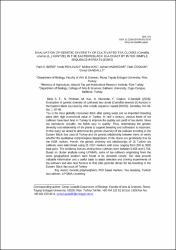Evaluation of genetic diversity of cultivated tea clones (Camellia sinensis (L.) Kuntze) in the eastern black sea coast by inter-simple sequence repeats (ISSRS)
Citation
Beris, F.S., Pehlivan, N., Kac, M., Haznedar, A., Coskun, F., Sandalli, C. (2016). Evaluation of genetic diversity of cultivated tea clones (Camellia sinensis (L.) Kuntze) in the eastern black sea coast by inter-simple sequence repeats (ISSRS). Genetika-Belgrade, 48(1), 87-96. https://doi.org/10.2298/GENSR1601087BAbstract
Tea is the most globally consumed drink after spring water and an important breeding plant with high economical value in Turkey. in half a century, various kinds of tea cultivars have been bred in Turkey to improve the quality and yield of tea plants. Since tea reproduces sexually, tea fields vary in quality. Thus, determining the genetic diversity and relationship of the plants to support breeding and cultivation is important. in this study we aimed to determine the genetic diversity of tea cultivars breeding in the Eastern Black Sea coast of Turkey and the genetic relationship between them, to verify whether the qualitative morphological designations of the clones are genetically true by the ISSR markers. Herein, the genetic diversity and relationships of 18 Turkish tea cultivars were determined using 15 ISSR markers with sizes ranging from 250 to 3000 base pairs. the similarity indices among these cultivars were between 0.456 and 0.743. Based on cluster analysis using UPGMA, some of tea cultivars originating from the same geographical position were found to be clustered closely. Our data provide valuable information and a useful basis to assist selection and cloning experiments of tea cultivars and also help farmers to find elite parental clones for tea breeding in the Eastern Black Sea coast of Turkey.


















